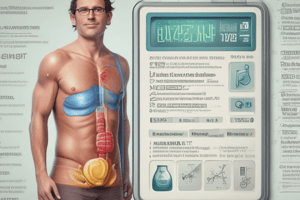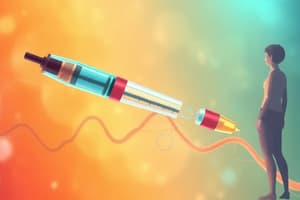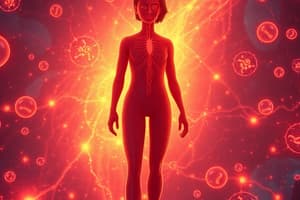Podcast
Questions and Answers
A patient needs an insulin with a rapid onset and short duration for mealtime coverage. Which of the following insulin types is most appropriate?
A patient needs an insulin with a rapid onset and short duration for mealtime coverage. Which of the following insulin types is most appropriate?
- Humulin 30/70
- Insulin glargine (Lantus)
- Humalog (correct)
- Humulin-N
A patient with type 1 diabetes requires basal insulin coverage that lasts approximately 24 hours with no pronounced peak. Which insulin best suits this need?
A patient with type 1 diabetes requires basal insulin coverage that lasts approximately 24 hours with no pronounced peak. Which insulin best suits this need?
- Humulin 30/70
- NovoRapid
- Insulin glargine (Lantus) (correct)
- Humulin-R
A patient is prescribed Humulin 30/70. What does this mean?
A patient is prescribed Humulin 30/70. What does this mean?
- 30% short-acting insulin and 70% long-acting insulin
- 30% intermediate-acting insulin and 70% short-acting insulin (correct)
- 30% intermediate-acting insulin and 70% long-acting insulin
- 30% rapid-acting insulin and 70% short-acting insulin
Which of the following best describes the onset of action of NovoRapid insulin?
Which of the following best describes the onset of action of NovoRapid insulin?
A patient experiencing diabetic ketoacidosis (DKA) requires intravenous insulin administration. Which insulin formulation is MOST suitable for IV bolus and infusion?
A patient experiencing diabetic ketoacidosis (DKA) requires intravenous insulin administration. Which insulin formulation is MOST suitable for IV bolus and infusion?
What is a primary mechanism of action for biguanides like metformin?
What is a primary mechanism of action for biguanides like metformin?
Which class of oral hypoglycemic drugs is most likely to cause hypoglycemia as a common adverse effect?
Which class of oral hypoglycemic drugs is most likely to cause hypoglycemia as a common adverse effect?
Which of the following oral hypoglycemic agents requires administration with food to be effective?
Which of the following oral hypoglycemic agents requires administration with food to be effective?
What is a common adverse effect associated with thiazolidinediones (TZDs)?
What is a common adverse effect associated with thiazolidinediones (TZDs)?
A newly diagnosed type 2 diabetic patient with no contraindications is prescribed first-line oral pharmacotherapy. Which of the following is the most appropriate choice?
A newly diagnosed type 2 diabetic patient with no contraindications is prescribed first-line oral pharmacotherapy. Which of the following is the most appropriate choice?
Which of the following best describes the mechanism of action of sulfonylureas?
Which of the following best describes the mechanism of action of sulfonylureas?
Compared to sulfonylureas, meglitinides have:
Compared to sulfonylureas, meglitinides have:
A patient takes Humulin-N every morning at 7:00 AM. Around what time would you expect this insulin to reach its peak effect?
A patient takes Humulin-N every morning at 7:00 AM. Around what time would you expect this insulin to reach its peak effect?
A patient reports frequent abdominal pain, diarrhea, and flatulence after starting a new medication for type 2 diabetes. Which of the following medications is MOST likely causing these symptoms?
A patient reports frequent abdominal pain, diarrhea, and flatulence after starting a new medication for type 2 diabetes. Which of the following medications is MOST likely causing these symptoms?
What is the duration of action of Humulin-R
What is the duration of action of Humulin-R
Which of the following types of insulin has no peak?
Which of the following types of insulin has no peak?
Which medication acts by inhibiting the enzyme alpha glucosidase in the small intestine?
Which medication acts by inhibiting the enzyme alpha glucosidase in the small intestine?
Which of the following insulins can be administered within 15 minutes of mealtime?
Which of the following insulins can be administered within 15 minutes of mealtime?
Which of the following insulins could be described as 'neutral protamine Hagedorn'?
Which of the following insulins could be described as 'neutral protamine Hagedorn'?
A patient is prescribed Novolin ge 30/70. Which of the following statements about this medication is correct?
A patient is prescribed Novolin ge 30/70. Which of the following statements about this medication is correct?
Flashcards
Rapid-acting insulin
Rapid-acting insulin
Begins working in 10-15 minutes; lasts 3.5-6 hours. Examples: Humalog, NovoRapid.
Short-acting insulin
Short-acting insulin
Works in 30 minutes, lasts 6.5 hours. Can be administered via IV bolus. Examples: Humulin-R, Novolin ge Toronto.
Intermediate-acting insulin
Intermediate-acting insulin
Starts in 2-4 hours, peaks in 4-10 hours, lasts 12-18 hours. Examples: Humulin-N, Novolin ge NPH.
Long-acting insulin analogue
Long-acting insulin analogue
Signup and view all the flashcards
Premixed Insulins
Premixed Insulins
Signup and view all the flashcards
Alpha-glucosidase inhibitors
Alpha-glucosidase inhibitors
Signup and view all the flashcards
Biguanides (Metformin)
Biguanides (Metformin)
Signup and view all the flashcards
Thiazolidinediones (TZDs)
Thiazolidinediones (TZDs)
Signup and view all the flashcards
Sulfonylureas
Sulfonylureas
Signup and view all the flashcards
Meglitinides
Meglitinides
Signup and view all the flashcards
Study Notes
Types of Insulin
- Rapid-acting insulin is often used within 15 minutes of mealtime.
- Humalog has an onset of 10-15 minutes, a peak of 1-2 hours, and a duration of 3.5-6 hours.
- NovoRapid has an onset of 10-15 minutes, a peak of 1-1.5 hours, and a duration of 3.5-4.75 hours.
- Short-acting insulin can be administered via IV bolus or IV infusion in cases of DKA.
- Humulin-R has an onset, peak, and duration of 30 minutes, 2-3 hours, and 6.5 hours respectively.
- The onset, peak, and dration of Novolin ge Toronto is the same as Humulin-R
- NPH, or neutral protamine Hagedorn, is an intermediate-acting insulin
- Humulin-N has an onset of 2-4 hours, a peak of 4-10 hours, and a duration of 12-18 hours.
- The onset, peak, and duration of Novolin ge NPH is the same as Humulin-N
- Insulin glargine (Lantus) is a long-acting analogue with an onset of 2-4 hours and a duration of 20-24 hours.
- Insulin glargine (Lantus) has no peak, which means blood levels do not rise and fall as with other insulins.
- Premixed insulins include Humulin 30/70 and Novolin ge 30/70.
- A single vial of premixed insulin contains 30% intermediate-acting insulin and 70% short-acting insulin.
Pharmacotherapy with Oral Hypoglycemics
- Alpha-glucosidase inhibitors inhibit the enzyme alpha glucosidase in the small intestine.
- Alpha glucosidase breaks down complex carbohydrates to monosaccharides, delaying the digestion and absorption of glucose.
- Alpha-glucosidase inhibitors must be taken with food as an adverse effect would be abdominal pain, diarrhea and flatulence.
- Biguanides (Metformin) decreases hepatic production of glucose, reduces insulin resistance (insulin receptor sensitivity), and may decrease intestinal absorption of glucose.
- Biguanides (Metformin) is considered a first-line drug for newly diagnosed DM2 if no contraindications exist.
- Common adverse effects of Biguanides (Metformin) are GI-related, including abdominal bloating, cramping, nausea, and diarrhea and these effects are usually self-limiting.
- Thiazolidinediones (TZDs) enhance sensitivity of insulin receptors to decrease insulin resistance, and directly stimulate peripheral glucose uptake.
- Thiazolidinediones (TZDs) inhibit glucose production in the liver and can cause fluid retention/peripheral edema and weight gain due to water retention or an increase in adipose tissue.
- Sulfonylureas bind to receptors of beta cells in the pancreas to stimulate the release of insulin and decrease the secretion of glucagon.
- The most common adverse effect of sulfonylureas is hypoglycemia alongside weight gain.
- Meglitinides are similar to sulfonylureas, but have a much shorter duration of action and must be given with each meal and stimulate the release of insulin from pancreatic beta cells.
- The adverse effects would be hypoglycemia and weight gain.
Studying That Suits You
Use AI to generate personalized quizzes and flashcards to suit your learning preferences.




